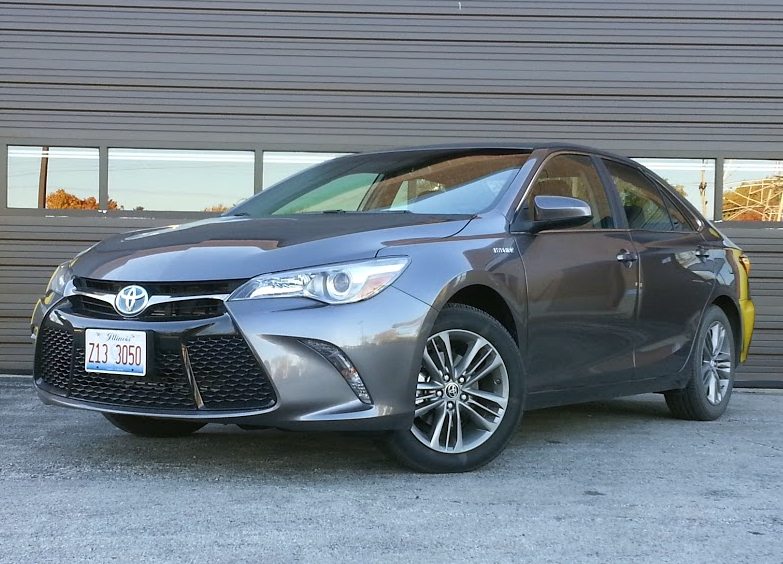
Class: Midsize Car
Miles Driven: 470
Fuel Used: 12.8 gallons
| CG Report Card | |
|---|---|
| Room and Comfort | B+ |
| Power and Performance | B- |
| Fit and Finish | B |
| Fuel Economy | A |
| Value | B+ |
| Report-card grades are derived from a consensus of test-driver evaluations. All grades are versus other vehicles in the same class. Value grade is for specific trim level evaluated, and may not reflect Consumer Guide's impressions of the entire model lineup. | |
| Big & Tall Comfort | |
| Big Guy | B |
| Tall Guy | B+ |
| Big & Tall comfort ratings are for front seats only. "Big" rating based on male tester weighing approximately 350 pounds, "Tall" rating based on 6'6"-tall male tester. | |
Real-world fuel economy: 36.7 mpg
Driving mix: 65% city, 35% highway
EPA-estimated fuel economy: 40/38/40 (city/highway/combined)
Base price: $27,995 (not including $835 destination charge)
Options on test car: Moonroof ($915), Qi wireless charging ($75)
Price as tested: $29,820
Quick Hits
The great: Fuel economy, hybrid refinement
The good: Ride quality, cabin room and comfort
The not so good: Trunk space compromised by hybrid battery
Check out our Midsize Car Best Buys
John Biel
Anyone who might have been pondering the purchase of a Toyota Camry Hybrid but couldn’t pull it off before his or her dealer ran out of 2015 stock can rest easy. The car comes back for 2016 practically the same way it was.
Consumer Guide® sampled a ’16 Camry Hybrid SE that was so like its ’15 test car that they even had the same $27,995 starting price. Except for a slightly revised roster of exterior-color offerings, one year’s Hybrid SE is just like the other. Of course, that brings the same high-mileage, long-range gas/electric powertrain. Driving dynamics, passenger accommodations, and equipment are familiar, too.
Test Drive: 2016 Nissan Altima 2.5 SL
The Camry Hybrid’s 2.5-liter dohc 4-cylinder engine and battery-fed motor provide a maximum 200 net system horsepower. In highway use, there’s sufficient power for safe, comfortable cruising, though the continuously variable transmission (CVT) lacks quick kick-down for snappy passing. Console buttons allow for the selection of electric-oriented “EV” and power-saving “Eco” modes. Off-the-line acceleration is slightly livelier in the “normal” setting. The electric-to-gas transition is fairly smooth.
This tester averaged 40.3 mpg from a turn of 78 miles, 75 percent in city-style driving, and running a bit more in Eco than in normal. That’s a slight improvement on the car’s 40-mpg city rating from the EPA, and a little better than the 39.4 mpg he recorded on a more highway-intensive drive with the ’15 model. (Highway mileage is pegged at 38 mpg.) As such, the Camry Hybrid has a one-tank range of very nearly 600 miles.
Steering effort is on the light side but is still quite responsive. Good bump absorption from the SE’s sport-tuned suspension helps make for a pretty smooth ride. The 17-inch low-rolling-resistance tires make a little noise on the highway, though, and braking requires a lot of pedal pressure.
As the middle model of three available Camry Hybrids, the SE comes with some sportier standard-equipment than the LE, notably its suspension, mesh grille, black-trim projector-beam headlights, and decklid spoiler. Other standards include dual-zone air conditioning, Smart Key with push-button start, acoustic windshield glass, heated exterior mirrors, a leather-trimmed steering wheel, rearview camera, and thin-film-transistor vehicle-information display. Hybrid-specific items include collision sensors that deactivate the high-voltage electric-motor battery, regenerative braking to return charge to the battery, and instrumentation that replaces the gas-engine Camry’s tachometer with a hybrid-system power meter.
The car tested was further kitted out with a $2290 option package of technology features, a power moonroof, and a Qi-compatible wireless smartphone charger. The core of this option consists of an integrated navigation system, Toyota’s Entune infotainment system with app suite, 7-inch touchscreen with split-screen display, upgraded AM/FM/CD/MP3 audio system, voice recognition, Bluetooth hands-free phone capability and music streaming, satellite radio, and traffic and weather alerts.
Seats dressed in “SofTex” imitation leather and textured cloth provide good support and long-drive comfort. Soft-touch materials cover the tops of the dash, doors, and arm rests, though molded plastic is still in evidence around the cabin. Dashes of bright metal provide some sparkle. Gauges are easy to read, as is the vehicle-information display. The audio system was intuitively simple to program with buttons and knobs around the touchscreen, though the upper right-hand tuner knob is a bit of a reach from the driver’s seat. Climate controls have their own display. Temperature is conveniently set by rotating dials; functions are activated by a few buttons, some of them repetitive-push.
Head and leg room are generous both in front and in back. Three adults could fit across the back—a low-profile floor hump helps here—though the middle passenger will be a little short of head room. Visibility is fairly good in all directions.
A small covered bin below the climate controls houses a power point, digital-device ports, and—when equipped—the wireless charger. The console sports two open cup holders, and a decently sized cubby under the arm rest. The glove box is wide and spacious. Doors have modest storage pockets with bottle holders. Rear passengers have the use of pouches on the backs of the front seats, twin cup holders in the pull-down center arm rest, and a small tray cut into the back of the console.
The shape and height of the trunk opening make loading easy, and the floor is wide and flat. The electric-motor battery pack housed just behind the rear seat trims 2.3 cubic feet of trunk space. It somewhat restricts passage to the lowered rear seat, which in the case of Hybrid models has a full-width folding seat back with a central pass-through.
If you’re a little late arriving at the coming-out party for this latest generation of the Camry Hybrid, relax; you haven’t missed anything yet.